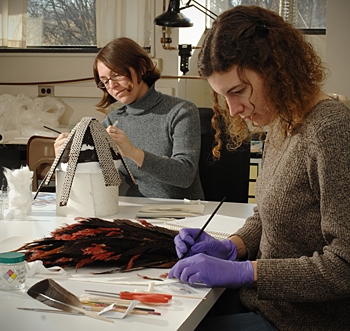
The funding, which will go toward programming and merit-based fellowships over the next two years, will pay for students' travel and research costs; honoraria for special guest lecturers in preventive, objects, painted surfaces and textile conservation; and other training expenses.
“Our program is very competitive,” said Debra Hess Norris, chairperson of UD's Art Conservation Department and associate dean for social sciences and history in the College of Arts and Sciences. “We accept only 10 graduate students each year, and they all receive full tuition scholarships, as well as fellowships. What this NEH fellowship will fund, primarily, are additional fellowship opportunities--conference and seminar fees and national and international research and travel expenses. Funds from the grant also will support the costs of bringing experts from across the nation to speak to our students about issues relating to preservation of historic sites or emergency response and recovery--an area for which UD is well-known.”
Norris added that the funding, besides strengthening the program's already notable opportunities, also allows for new directions in the field and advances ongoing ventures such as public outreach and collaboration with other institutions.
“Funds provided by the NEH allow us to give a greater focus to engaging the public in the preservation of our national heritage and to work with other institutions, including historically black colleges and universities, to assist with their collections,” she said.
To this end, the program offers a once-a-month conservation clinic, and an upcoming field trip to North Carolina Agricultural and Technical State University in Greensboro, N.C., will give objects conservation students a chance to work with decades-old cultural artifacts from Africa.
“Because the focus of our program is to ensure that our students are well-versed in all areas of conservation and highly skilled and critical thinkers, real-life experience is the best way to learn,” Norris said. “Our students are likely to be employed by major museums working on important and highly diverse objects, we want to ensure that they are the best conservators possible for whatever they encounter.”
What graduates do encounter, Norris added, is always a happy surprise for her. “The list of achievements of our graduates is impressive,” she said, “and the objects they've worked on include everything from the Dead Sea Scrolls to the Star-Spangled Banner, to R2D2 to Spock's ear to Liberace's rhinestones.” Documents such as the Constitution of the United States, the Declaration of Independence, the Treaty of Paris and Babe Ruth's baseball contract also have made the list.
“While the ethics and philosophy of conservation are similar across disciplines, the materials and conservation challenges can be vastly different--graduates of our program will likely encounter modern plastics and archaeological fragments--and we need to be certain our students know how conserve and care for them all,” Norris said.
Lauren McMullen, a second-year graduate student specializing in objects conservation, said that she chose the program at UD because of its reputation and strong emphasis on science.
“My bachelor's degree and background is in sculpture, and I really liked how [WUDPAC] offered a good science background, as well,” she said. “I thought that attending [WUDPAC] would be a good way to work on that aspect, because I feel a lot more comfortable in the arts than I do in the sciences, and I liked how the two components work together here.”
McMullen, who spent last summer interning at the Carnegie Museum of Natural History in Pittsburgh, where she worked on the “Dinosaurs in Our Time” exhibition, hopes to complement that experience with an internship this summer at a museum featuring modern and contemporary art. She said that the range of projects on which WUDPAC students get to work is also what drew her to the program.
“In our first year, we go through all the different areas that we specialize in, and in our second year we get to work on projects in the area in which we've decided to focus,” she said. “I've decided to focus on objects, so this year I'm working on treatments for a variety of different kinds of materials--glass, ceramics, composites, metals, archaeological artifacts and ethnographic objects. We have the whole year to plan when these projects will be done, and we make our own schedule and have the full year to complete the treatments.”
Katherine Wight, also a second-year graduate student specializing in objects conservation, with a special interest and background in glass, said that she was drawn to WUDPAC because of its reputation.
“WUDPAC is a very structured program,” she said. “All the teachers are very knowledgeable and the setting is absolutely gorgeous, and working at Winterthur gives you the opportunity to really focus on studying.”
After spending last summer interning in the conservation lab at the Brooklyn Museum, where she worked on preparing pre-dynastic Egyptian objects for a 14-venue loan, she applied for--and secured--one of only two coveted slots for an internship this summer working at the excavation site at the Agora in Athens, Greece, maintained by the American School of Classical Studies.
The story of WUDPAC's success also is borne out by statistics: As of September 2006, the program had graduated 287 master's-level students, and all but eight living graduates currently work in the field of conservation.
Norris, who every year provides annual reports on the program to the NEH, said that WUDPAC's success and the funding it regularly receives from the NEH are team efforts that rely a great deal on the established bond with Winterthur and a corps of dedicated WUDPAC faculty and scholars.
“The recent NEH grant is a wonderful acknowledgement of the program,” she said. “And what makes our program especially strong is the unique collaboration we have between the University and Winterthur and our exceptionally talented faculty and staff. They contribute their skills, expertise and knowledge to the program, and that's ultimately what allows us to attract strong applicants and to graduate very skilled and informed conservators with enormous potential.”
Article by Becca Hutchinson
Photo by Kathy Atkinson

